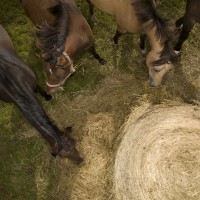Forage prevents stereotypies

Captive animals faced with insoluble problems can develop behavioural disturbances, stereotypies. Examples of behavioural disturbances are weaving, crib-biting, box-walking and wood-chewing. Many factors influence the development of behavioural disturbances but how much forage the horse is fed is one of the main factors.
The results from these studies show that the more forage horses were fed the lesser the risk of behavioural disturbances. Therefore it is recommended that the absolute minimum allowance of coarse fodder is 1.5 kg DM/100 kg body weight and day, if you have to restrict the allowance of coarse fodder/forage 2.0 – 2.5 kg DM/100 kg body weight and day is appropriate, but free access to forage of suitable quality works well for many horses.
The amount of concentrate had the opposite effect; the more concentrate the bigger risk of behavioural disturbances. Straw as bedding also decreased the risk of behavioural disturbances. That forage decreases the risk of behavioural disturbances can partly be due to that a high forage intake provides enough fibre, but more forage also means occupation e.g. that the horses behavioural need for eating during a longer period of time is fulfilled. It is important to prevent behavioural disturbances because when they are developed they are difficult to get rid of.
Sara Muhonen, AgrD
References:
Jansson A, Lindberg JE, Rundgren M, Müller C, Connysson M, Kjellberg L & Lundberg M. 2011. Utfodringsrekommendationer för häst. Inst. för Husdjurens Utfodring och Vård, SLU.
